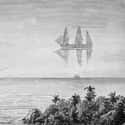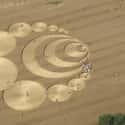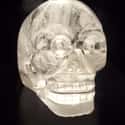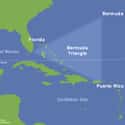-
(#7) The 'Flying Dutchman' Ghost Ship Was Likely The Result Of A Common Optical Illusion
Practically since sailing was first invented, sailors have reported seeing mysterious floating objects on the horizon. The most famous of these is the "Flying Dutchman," sightings of which likely originated in the 1600s - but persisted into the 20th century. Usually, these sightings had similar details: A ghostly ship appears just over the horizon, appearing to be lit by some kind of unearthly light, usually during a storm. Sailors theorized that this ghost ship was a former Dutch trading vessel doomed to sail the ocean for eternity, and whenever it appeared before living sailors, it was a bad omen. Poems about ghost ships helped spread these legends even further, like Walter Scott's Rokeby or Samuel Taylor Coleridge's The Rime of the Ancient Mariner.
Ghost ships are just one type of unearthly object people have spotted at sea. In 1643, the Jesuit priest Domenico Giardina reported seeing a floating city over the strait of Messina, just over the horizon. In 1810, cartographers Yakov Sannikov and Matvei Gedenschtrom reported seeing a floating land mass among the New Siberian Islands.
In reality, reports of ghost ships, ghost cities, and ghost islands are all examples of a common optical illusion called "Fata Morgana." (The name derives from the character Morgan le Fay, a sorceress from the legend of King Arthur who could create beguiling illusions.) A Fata Morgana is caused by the way our eye perceives light when it passes through spaces with different densities. At the ocean's surface, the water keeps the air relatively cool. Above that layer of cool air is another layer of warmer air. These differences in temperature create atmospheric layers with different densities. When light passes through them, it refracts, or bends. The human eye assumes the light it can see travels in a straight line, so from a distance, refraction can make an object on the water's surface appear as if it's floating above it. Most likely, superstitious sailors probably were seeing real ships. They just looked like they were floating in the air.
Fata Morganas are convincing enough that even though we now know their cause, we can still fall for them. In 2015, residents of Foshan and Jiangxi reported seeing a floating city in the sky. Once again, it was just a mirage.
-
(#12) Crop Circles Can Be Created With Simple Ropes And Boards
Crop circles were one of the more baffling phenomena of modern times. They usually appeared suddenly overnight. They looked like an unknown force had flattened the crops in a field into precise geometric patterns, all without damaging them. Reports of crop circles actually appear as early as the 16th century. But they became an object of public fascination in 1978, when one appeared in a field near Warminster, in Wiltshire, England. Afterward, hundreds of crop circles appeared throughout southern England and across the world. Without a scientific explanation, people came up with all sorts of theories to explain them, among meteorological forces and, of course, the usual suspect, aliens. It was believed that crop circles were actually "flying saucer nests," or sites of UFO landings. To some, they're the most concrete proof yet of extraterrestrial life.
Are crop circles just another misunderstood natural phenomenon, like most of the other mysteries on this list? Nope. This time, it was all a hoax. In 1991, friends Doug Bower and Dave Chorley came forward and admitted they had created the original Wiltshire crop circle. They admitted they'd been inspired by a letter published in a 1963 issue of New Scientist about "flying saucer nests," and decided to have some fun and see if they could make one themselves. They even showed the BBC exactly how they made it: They used a contraption called a "stalk stomper," or a simple board with ropes tied on each end. One of them stood holding one end of the rope, while the other stretched the opposite end of the rope as far as it would go and walked in a circle, allowing the board to gently push over the plant stalks. Bower and Chorley admitted to making hundreds of crop circles across England, always working under the cover of darkness.
-
(#9) Ancient Civilizations Didn’t Carve Crystal Skulls; They’re All Relatively Recent
People have been fascinated with crystal skulls long before 2008's Indiana Jones and the Kingdom of the Crystal Skull. These hunks of quartz carved into the shape of a human skull supposedly originate from pre-Columbian Mesoamerican civilizations like the Aztecs, the Mayans, the Toltecs, and the Olmecs. They first attracted worldwide attention in the late 19th century when a French antiquarian operating in Mexico City, Eugène Boban, claimed to have discovered authentic Aztec crystal skulls and sold them to a private collector. Crystal skulls soon became a sought-after collector's item, and not just because they were curiosities. Some believed the skulls had healing properties or gave their owners psychic abilities. Others believed they were related to the lost city of Atlantis, and still others believed they were of extraterrestrial origin.
Crystal skulls have remained in museums like the British Museum, so modern archaeologists have been able to examine them and determine where they come from. The verdict? All evidence points to crystal skulls being fakes. For starters, no crystal skull has ever been found in situ at an authentic Mesoamerican archaeological site, meaning there's no way to prove they actually are of ancient origin. By using electron microscopes, archaeologists determined that the techniques used to make the skulls could only have been made with 19th century metal equipment, and not the stone, wooden, or bone tools Mesoamerican civilizations had access to. Most of all, the quartz used to create the skulls comes from either Brazil or Madagascar, neither of which are home to any of those four Mesoamerican civilizations. In the late 19th century, Europeans and Americans were becoming more interested in Mesoamerican cultures, and it's likely the skulls were created to capitalize on this trend.
-
(#4) The Death Valley Sailing Stones Don't Move On Their Own, They Float On Pieces Of Ice
The Racetrack Playa is a flat, dry lakebed in the middle of a desert with the lowest elevation in North America. It's also home to mysterious "sailing stones" that have baffled visitors since the early 1900s. To an untrained observer, it looks like these stones have moved across the surface of the lakebed entirely on their own, leaving tracks up to 1,500 feet long without any sign of human or animal interference. Many theories have been offered to explain this phenomenon, including strong winds, the pull of the Earth's magnetic field, a clever prankster - or, once again, aliens.
But thanks to a devoted team of scientists, we now know why these stones move. In 2011, researchers from the Scripps Institute of Oceanography attached GPS devices to 15 rocks and left to monitor them. Two years later, they returned to the site and were lucky enough to witness the phenomenon in person. When Death Valley receives a rare winter rainstorm, water can pool on the flat lakebed and freeze overnight, creating large panes of ice around the rocks. In the morning, the ice thaws and cracks into large sheets, and a light gust of wind is all that's needed to move the ice across the lakebed's surface. The ice sheets push the rocks across the lakebed and then melt, leaving nothing behind but the rock's tracks. The scientists called the phenomenon "ice shoving." One of them jokingly described the study as "the most boring experiment ever."
-
(#10) Ships Disappear In The Bermuda Triangle At About The Same Rate As They Do Anywhere Else
For decades, sailors, pilots, and travelers have feared the Bermuda Triangle, the vaguely triangle-shaped area of the Atlantic Ocean where at least 50 ships and 20 airplanes have "mysteriously" vanished. Stories about disappearances in the Bermuda Triangle area date back to the middle of the 19th century, but the name "Bermuda Triangle" was coined in 1964 by pulp science-fiction writer Vincent Gaddis, who wrote an article about it for Argosy magazine. Over the years, many theories have attempted to explain these disappearances, including Earth's magnetic field interfering with navigational instruments; enormous bubbles of methane gas bursting on the surface of the ocean; cryptids like sea monsters or aliens; and something to do with the lost city of Atlantis.
The point is not to debunk these explanations, because the real flaw in the Bermuda Triangle theory is the premise that an unusually high number of mishaps involving ships and planes happen there. Pilot and author Larry Kusche spent years researching these disappearances, and he found that many of the reported disappearances didn't actually occur within the Bermuda Triangle. As for those shipwrecks and plane incidents, Kusche and others like the National Oceanographic and Atmospheric Administration have pointed out that maritime disasters occur at about the same rate within the Triangle as they do everywhere else.
-
(#5) 'The Bloop,' An Underwater Noise That Sounded Like A Deep-Sea Monster, Was The Sound Of An Icequake
The ocean is still relatively unexplored, and some believe it's just as mysterious as the depths of outer space. Recently, a strange phenomenon seemed to give credence to the belief that unknown terrors might still lurk beneath the ocean's surface. In 1997, researchers at the National Oceanographic Atmospheric Administration (NOAA), who were using underwater hydrophones to detect volcanic activity, recorded a mysterious sound in the southern Pacific Ocean they described as a "bloop." Since the bloop sounded like it was made by an animal, similar to a whale's mating call, and because it originated over 5,000 kilometers from the listening station, some speculated that it was caused by a previously unknown sea monster.
But the NOAA investigated the sound further and determined it wasn't an animal at all. By comparing the bloop's acoustics with other sound recordings taken in Antarctica, they recognized it had the same characteristics as the sound of "ice calving," AKA an "icequake," or the phenomenon of an iceberg breaking away from a glacier as it melts. Part of the confusion came from the fact that the original bloop recording was often replayed at 16 times its actual speed, which made it sound a lot less like a rumbling quake and more like an animal.
New Random Displays Display All By Ranking
About This Tool
Our data comes from Ranker, If you want to participate in the ranking of items displayed on this page, please click here.






